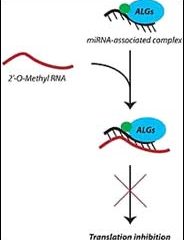Life Sciences and Chemistry
Articles and reports from the Life Sciences and chemistry area deal with applied and basic research into modern biology, chemistry and human medicine.
Valuable information can be found on a range of life sciences fields including bacteriology, biochemistry, bionics, bioinformatics, biophysics, biotechnology, genetics, geobotany, human biology, marine biology, microbiology, molecular biology, cellular biology, zoology, bioinorganic chemistry, microchemistry and environmental chemistry.

Exploring small RNA function
Regulation of gene expression–deciding how much of what proteins are produced in the cell–is controlled by a myriad of different molecules. One type of naturally occurring regulatory molecule is small interfering RNA (siRNA), which selectively disrupts the production of a protein it is programmed to recognize, a process called RNA interference. These short stretches of nucleotides combine with other cellular proteins to form an RNA-induced silencing complex, called RISC, which locates and destroys

Despite confinement, crop genes can spread fast to wild
With the slim chance that farmers will stop planting crops containing genes from other organisms, researchers have started to develop strategies that trap these foreign genes, reducing the risk that they’ll spread to wild relatives.
But an investigation by scientists from the University of Wisconsin-Madison and the University of Minnesota-St. Paul shows that these containment strategies can quickly fail.
Using mathematical models, the team of scientists explored the effective

USC researchers produce a hairier mouse
Transgenic mouse shows other intriguing physiological changes
A transgenic mouse designed to grow more hair than other mice has provided University of Southern California researchers with some surprising results-and insight into the development and regulation of growth in epithelial organs that extend beyond skin and hair.
In an upcoming paper in the American Journal of Pathology—now available online—Cheng-Ming Chuong, M.D., Ph.D., professor of pathology at the Keck School o

Computer method identifies potentially active enzymes
Better drugs, improved industrial applications and even cleaner laundry may be possible with a new computer method to predict which hybrid enzymes are likely to have high activity, according to a team of Penn State chemists and chemical engineers.
“FamClash is quite successful at qualitatively predicting the pattern of the specific activity of the hybrids,” the researchers report in this week’s online issue of the Proceedings of the National Academy of Sciences. “By identifying incompat

Jefferson scientists unlocking secrets of cholesterol transport in body
Scientists at Jefferson Medical College and Jefferson’s Kimmel Cancer Center have discovered one part of the mechanism behind a popular anti-cholesterol drug.
Steven Farber, Ph.D., assistant professor of microbiology and immunology at Jefferson Medical College of Thomas Jefferson University in Philadelphia, Eric Smart, Ph.D., at the University of Kentucky and their co-workers have found that treating hypercholesterolemic mice with the drug ezetimibe (Zetia) disrupts a complex of two pro

Herbarium database provides global access for researchers
Already renowned as a leading centre for plant science research, the University of Reading’s Herbarium is now a world resource for botanists after the launch of a new internet website featuring an ever-expanding database of specimens.
The Herbarium, which was founded in 1900, contains 264,500 plant specimens from around the world, with a particular focus on the United Kingdom and Mediterranean countries such as Spain and Morocco.
There are extensive collections of phanerogams, pter